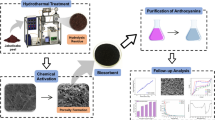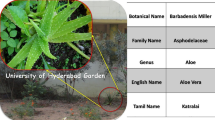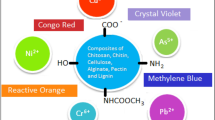Abstract
The copolymerization of aniline and pyrrole in the presence of SBA-15 resulted in the formation of the SBA-15/PANI/PPy composite. Low-angle and wide-angle X-ray diffraction (XRD), Fourier transformed infra-red spectroscopy (FT-IR), Field emission scanning electron microscopy (FESEM), Thermo gravimetric analysis (TGA), High resolution transmission electron microscopy (HRTEM) and Brunauer–Emmett–Teller (BET) analysis were used to characterize the materials. The effects of pH, adsorbent amount, dye concentration, contact time and temperature on the removal of sunset yellow, indigo carmine, titan yellow and orange G dyes from aqueous solutions were investigated using adsorption techniques. From the low-angle XRD analysis, the peaks confirm the formation of a mesoporous SBA-15 (p6mm, hexagonal) structure. From FT-IR analysis, the peaks at 1568, 1492 and 1399 cm−1 are attributed to the C=C pyrrole ring and C–N stretching vibrations of aniline. The FESEM image of SBA-15 reveals that the structure exhibits a worm-like, folded morphology. The HRTEM image of the SBA-15/PANI/PPy composite showed that the mesopores are arranged in an orderly manner. Additionally, there are dark spots on it as a result of the polypyrrole and polyaniline being present. All of the dyes were removed with efficiency higher than 95%. The isotherm was confirmed to match the Langmuir isotherm model because the R2 value for all dyes was greater than 0.99. Sunset yellow, indigo carmine, titan yellow, and orange G had maximum adsorption capacities of 476.19, 384.61, 500.00 and 625.00 mg/g, respectively. The adsorption kinetics followed a pseudo-second-order model and the R2 value for all dyes was greater than 0.99. The thermodynamic parameters ΔG°, ΔS° and ΔH° all had negative values, indicating that the adsorption was spontaneous, decreased entropy, and exothermic. For five cycles, the SBA-15/PANI/PPy composite showed a 95% removal efficiency of dyes. Therefore, the prepared adsorbent can be used to clean industrial effluents that contain dyes.






















Similar content being viewed by others
Data availability
All data generated or analysed during this study are included in this manuscript.
References
M. Bhaumik, R. McCrindle, A. Maity, Efficient removal of Congo red from aqueous solutions by adsorption onto interconnected polypyrrole–polyaniline nanofibres. Chem. Eng. J. 228, 506–515 (2013)
N. Aarab, A. Hsini, A. Essekri, M. Laabd, R. Lakhmiri, A. Albourine, Removal of an emerging pharmaceutical pollutant (metronidazole) using PPY-PANi copolymer: kinetics, equilibrium and DFT identification of adsorption mechanism. Groundw. Sustain. Dev. 11, 100416 (2020)
B. Madhumita, A. Maity, V.V. Srinivasu, M.S. Onyango, Removal of hexavalent chromium from aqueous solution using polypyrrole-polyaniline nanofibers. Chem. Eng. J. 181, 323–333 (2012)
W. Huang, S. Wang, D. Li, Polymers and polymer composites for adsorptive removal of dyes in water treatment, in Sustainable polymer composites and nanocomposites. ed. by S. Inamuddin Thomas, R. Kumar Mishra, A. Asiri (Springer, Cham, 2019)
A. Khadir, M. Negarestani, H. Ghiasinejad, Low-cost sisal fibers/polypyrrole/polyaniline biosorbent for sequestration of reactive orange 5 from aqueous solutions. J. Environ. Chem. Eng. 8, 103956 (2020)
H. Yongshun, J. Li, X. Chen, X. Wang, Applications of conjugated polymer based composites in wastewater purification. RSC Adv. 4(107), 62160–62178 (2014)
H. Javadian, Application of kinetic, isotherm and thermodynamic models for the adsorption of Co (II) ions on polyaniline/polypyrrole copolymer nanofibers from aqueous solution. J. Ind. Eng. Chem. 20(6), 4233–4241 (2014)
D. Soumi, S.K. Srivastava, A.K. Gupta, Polypyrrole–polyaniline copolymer coated green rice husk ash as an effective adsorbent for the removal of hexavalent chromium from contaminated water. Mater. Adv. 2(7), 2431–2443 (2021)
M. Janmohammadi, M. Baghdadi, T.M. Adyel, N. Mehrdadi, Waste plastic filter modified with polyaniline and polypyrrole nanoparticles for hexavalent chromium removal. Sci. Total. Environ. 752, 141850 (2021)
J. Shen, S. Zhang, Z. Zeng, J. Huang, Yi. Shen, Y. Guo, Synthesis of magnetic short-channel mesoporous silica SBA-15 modified with a polypyrrole/polyaniline copolymer for the removal of mercury ions from aqueous solution. ACS Omega 6(39), 25791–25806 (2021)
V.D. Thao, L.G. Bach, V.T. Tran, Free-standing polypyrrole/polyaniline composite film fabricated by interfacial polymerization at the vapor/liquid interface for enhanced hexavalent chromium adsorption. RSC Adv. 9(10), 5445–5452 (2019)
S. Prashanna Suvaitha, K. Venkatachalam, A study of kinetics, thermodynamics, and adsorption isotherms of food and textile dyes removal with SBA-15 supported polyaniline nanocomposite. Water Air Soil Pollut. 234(4), 264 (2023)
R. Thilak Kumar, S. Umamaheswari, FTIR, FTR and UV-Vis analysis of carbamazepine. Res J. Pharm. Biol. Chem. Sci 2, 685–693 (2011)
S. Hashemikia, N. Hemmatinejad, E. Ahmadi, M. Montazer, Optimization of tetracycline hydrochloride adsorption on amino modified SBA-15 using response surface methodology. J. Colloid Interface Sci. 1(443), 105–114 (2014)
D. Dilek, U. Beker, Cr (VI) adsorption onto biomass waste material-derived activated carbon, in Desalination updates. ed. by R.Y. Ning (IntechOpen, London, 2015), pp.273–302
M.K. Seliem, S. Komarneni, M.R. Abu Khadra, Phosphate removal from solution by composite of MCM-41 silica with rice husk: kinetic and equilibrium studies. Microporous Mesoporous Mater. 224, 51–57 (2016)
A. Shahbazi, H. Younesi, A. Badiei, Functionalized SBA-15 mesoporous silica by melamine-based dendrimer amines for adsorptive characteristics of Pb (II), Cu (II) and Cd (II) heavy metal ions in batch and fixed bed column. Chem. Eng. J. 168(2), 505–518 (2011)
R. Seema, K. Sumanjit, R.K. Mahajan, Synthesis of mesoporous material SBA-3 for adsorption of dye congo red. Desalin. Water Treat. 57(8), 3720–3731 (2016)
K. Inderpreet, D. Mandiyal, B. Pal Singh, R. Kumar, J. Chawla, Amino-functionalized mesoporous MCM-41: an efficient adsorbent for the removal of chromium (III) ions from aqueous solution. J. Water Supp. Res. Technol. AQUA 65(6), 480–493 (2016)
M. Maryam, A. Rashidi, H.A. Tayebi, M.E. Yazdanshenas, Removal of anionic dye from aqueous media by adsorption onto SBA-15/polyamidoamine dendrimer hybrid: adsorption equilibrium and kinetics. J. Chem. Eng. Data 62(4), 1365–1376 (2017)
E.A. Newton, N. Ayawei, D. Wankasi, Interpretation of adsorption thermodynamics and kinetics. Open J. Phys. Chem. 10(3), 166–182 (2020)
M.A. Ibrahim, A.A.S. Mohammed, R.H. Yaseen, A.H. Haitham, M.A. Khalid, J.M. Sabah, H.M. Mohd, A.H. Hassimi, Simultaneous adsorption of ternary antibiotics (Levofloxacin, Meropenem, and Tetracycline) by sunflower husk coated with copper oxide nanoparticles. J. Ecol. Eng. (2022).
C. Saka, Ö. Şahin, H. Adsoy, ŞM. Akyel, Removal of methylene blue from aqueous solutions by using cold plasma, microwave radiation and formaldehyde treated acorn shell. Sep. Sci. Technol. 47(10), 1542–1551 (2012)
M.S. Salman, S.A. Hasanain, A.A. Qahtan, J.M.R. Mohanad, J.M. Sabah, M.A. Khalid, Cladophora algae modified with CuO nanoparticles for tetracycline removal from aqueous solutions. Water Air Soil Pollut. 233(8), 321 (2022)
S. Shariati, A. Chinevari, M. Ghorbani, Simultaneous removal of four dye pollutants in mixture using amine functionalized Kit-6 silica mesoporous magnetic nanocomposite. SILICON 2, 1865–1878 (2020)
Z. Esvandi, R. Foroutan, S.J. Peighambardoust, A. Akbari, B. Ramavandi, Uptake of anionic and cationic dyes from water using natural clay and clay/starch/MnFe2O4 magnetic nanocomposite. Surfaces Interfaces 21, 100754 (2020)
H.O. Chukwuemeka-Okorie, F.K. Ekuma, K.G. Akpomie, J.C. Nnaji, A.G. Okereafor, Adsorption of tartrazine and sunset yellow anionic dyes onto activated carbon derived from cassava sievate biomass. Appl Water Sci 11, 27 (2021)
R. El-Sharkawy, H.A. El-Ghamry, Multi-walled carbon nanotubes decorated with Cu (II) triazole Schiff base complex for adsorptive removal of synthetic dyes. J. Mol. Liq. 282, 515–526 (2019)
Y. Song, R. Peng, L. Gou, M. Ye, Removal of sunset yellow by methanol modified walnut shell. Iran. J. Chem. Chem. Eng.J. Chem. Chem. Eng. 40(4), 1095–1104 (2021)
M. Tayebeh, Kn. Gholamreza, Application of magnesium oxide nanoparticles for sunset yellow removal in aqueous solutions: adsorption isotherm, kinetic and thermodynamic studies. Iran. J. Chem. Chem. Eng. 41(12), 3939–3949 (2022)
M.E. Mahmoud, A.M. Abdelfattah, R.M. Tharwat, G.M. Nabil, Adsorption of negatively charged food tartrazine and sunset yellow dyes onto positively charged triethylenetetramine biochar: optimization, kinetics and thermodynamic study. J. Mol. Liq. 318, 114297 (2020)
G.A. Tabi, L.N.R. Blaise, K. Daouda, A.N. Odogu, A.A. Victoire, N.N. Julius, K.J. Mbadcam, Non-linear modelling of the adsorption of Indigo Carmine dye from wastewater onto characterized activated carbon/volcanic ash composite. Arab. J. Chem. 15, 103515 (2022)
M. El-Kammah, E. Elkhatib, S. Gouveia, C. Cameselle, E. Aboukila, Enhanced removal of Indigo Carmine dye from textile effluent using green cost-efficient nanomaterial: adsorption, kinetics, thermodynamics and mechanisms. Sustain. Chem. Pharm. 29, 100753 (2022)
A.O. Dada, F.A. Adekola, E.O. Odebunmi, F.E. Dada, O.M. Bello, B.A. Akinyemi, O.S. Bello, O.G. Umukoro, Sustainable and low-cost Ocimumgratissimum for biosorption of indigo carmine dye: kinetics, isotherm and thermodynamic studies. Int. J. Phytoremediation 22(14), 1–14 (2020)
A.N. Babu, D. Srinivasa Reddy, P. Sharma, G. Suresh Kumar, K. Ravindhranath, G.V. Krishna Mohan, Removal of hazardous indigo carmine dye from waste water using treated red mud. Mater. Today Proc. 17, 198–208 (2019)
S. Bhowmik, V. Chakraborty, P. Das, Batch adsorption of indigo carmine on activated carbon prepared from sawdust: a comparative study and optimization of operating conditions using response surface methodology. Res. Surfaces Interfaces 3, 100011 (2021)
R.M. Ferreira, N.M. de Oliveira, L.L.S. Lima, A.L.D.M. Campista, D.M.A. Stapelfeld, Adsorption of indigo carmine on Pistia stratiotes dry biomass chemically modified. Environ. Sci. Pollut. Res. 26, 28614–28621 (2019)
M. Adel, M.A. Ahmed, A.A. Mohamed, Effective removal of indigo carmine dye from wastewaters by adsorption onto mesoporous magnesium ferrite nanoparticles. Environ. Nanotechnol. Monit. Manag. 16, 100550 (2021)
D. Sikdar, S. Goswami, P. Das, Activated carbonaceous materials from tea waste and its removal capacity of indigo carmine present in solution: synthesis, batch and optimization study. Sustain. Environ. Res. 30, 30 (2020)
J. Mittal, R. Ahmad, A. Mittal, Kahwa tea (Camellia sinensis) carbon—a novel and green low-cost adsorbent for the sequestration of Titan yellow dye from its aqueous solutions. Desalin. Water Treat. 227, 404–411 (2021)
M. El-Azazy, S.N. Dimassi, A.S. El-Shafie, A.A. Issa, Bio-waste aloe vera leaves as an efficient adsorbent for titan yellow from wastewater: structuring of a novel adsorbent using plackett-burman factorial design. Appl. Sci. 9, 4856 (2019)
M.A. Salem, I.A. Salem, M.G. Hanfy, A.B. Zaki, Removal of titan yellow dye from aq. solutions with polyaniline/Fe3O4 nanocomposite. Eur. Chem. Bull. 5(3), 113–118 (2016)
P. Pietrzyk, N.T. Phuong, S.J. Olusegun, N. Hong Nam, D.T.M. Thanh, M. Giersig, P. Krysinski, M. Osial, Titan yellow and congo red removal with superparamagnetic iron-oxide-based nanoparticles doped with zinc. Magnetochemistry 8, 91 (2021)
A. Malik, A. Khan, N. Shah, M.S. Khan, The kinetics and equilibrium thermodynamics study on the removal of direct blue and titan yellow dyes from aqueous media by modified rice husk char. Z. Phys. Chem. 2019, 10 (2019)
P.B. Sibanda, S. Majoni, L.L. Sibali, H. Chiririwa, Kinetics and equilibrium adsorption studies of removal of anionic dyes from water using calcined layered double hydroxides. Poll. Res. 40(1), 308–316 (2021)
S. Banerjee, M.C. Chattopadhyaya, Y.C. Sharma, Removal of an azo dye (Orange G) from aqueous solution using modified sawdust. J. Water Sanit. Hyg. Dev. 5(2), 235–243 (2015)
A. Malik, A. Khan, M. Humayun, Preparation and chemical modification of rice husk char for the removal of a toxic dye (orange G) from aqueous medium. Z. Phys. Chem. 233, 375 (2018)
Z. Gao, L. Zhang, X. Shi, J. Yang, X. Wang, Study on the adsorption of orange G dye by the PA65 with pore structure. Water Air Soil Pollut. 234, 230 (2023)
S. Prakash, K.V. Sanjay, Decolourization of orange G dye by microalgae acutodesmus obliquus strain PSV2 isolated from textile industrial site. Int. J. Appl. Sci. Biotechnol. 1(4), 47–252 (2013)
B. Amit, A.K. Minocha, J. Byong-Hun, P. Ju-Myon, L. Giehyeon, A adsorption of orange G dye on paper mill sludge: equilibrium and kinetic modeling. Fresenius Environ. Bull. 16, 1049–1055 (2007)
M. Arulkumar, P. Sathishkumar, T. Palvannan, Optimization of Orange G dye adsorption by activated carbon of Thespesia populnea pods using response surface methodology. J. Hazard. Mater. 186(1), 827–834 (2011)
A.A. Atia, A.M. Donia, W.A. Al-Amrani, Adsorption/desorption behavior of acid orange 10 on magnetic silica modified with amine groups. Chem. Eng. J. 150(1), 55–62 (2009)
I.D. Mall, V.C. Srivastava, N.K. Agarwal, Removal of orange-G and methyl violet dyes by adsorption onto bagasse fly ash kinetic study and equilibrium isotherm analyses. Dyes Pigments 69(3), 210–223 (2006)
Funding
The authors gratefully thank financial support from RUSA 2.0, India, Ref: No. C3/RI&QI/RUSA 2.0/Theme-2 Project/Award/2021/032 dt.:03.02.2021 (University of Madras).
Author information
Authors and Affiliations
Contributions
PSS had done the methodology part, formal analysis, investigation, and writing original draft preparation. VK had done the supervision, project administration and funding acquisition.
Corresponding author
Ethics declarations
Competing interests
The authors declare no competing interests.
Ethical approval
This article does not involve any animal or human subject experiment.
Additional information
Publisher's Note
Springer Nature remains neutral with regard to jurisdictional claims in published maps and institutional affiliations.
Rights and permissions
Springer Nature or its licensor (e.g. a society or other partner) holds exclusive rights to this article under a publishing agreement with the author(s) or other rightsholder(s); author self-archiving of the accepted manuscript version of this article is solely governed by the terms of such publishing agreement and applicable law.
About this article
Cite this article
Suvaitha, S.P., Venkatachalam, K. Adsorptive separation of food and textile dyes from aqueous solution by SBA-15 supported polyaniline/polypyrrole composite: isotherms, kinetics, thermodynamics and recyclability study. J Mater Sci: Mater Electron 35, 94 (2024). https://doi.org/10.1007/s10854-023-11839-z
Received:
Accepted:
Published:
DOI: https://doi.org/10.1007/s10854-023-11839-z




